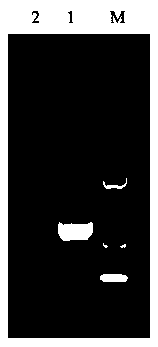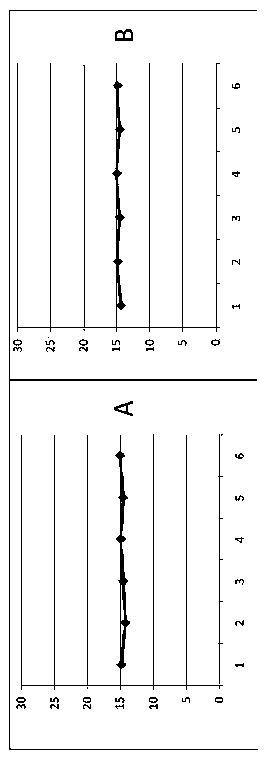Preparing method for GI type norovirus virus-like particles and application thereof
A technology of virus-like particles, applied in the preparation and application of GI-type norovirus virus-like particles, can solve the problems of biological safety hazards, easy to be degraded by ribonuclease, unable to reflect the influence of nucleic acid extraction process, etc., to achieve a solution The problem of stability, the convenience of large-scale promotion and application, and the effect of avoiding the risk of false negatives
- Summary
- Abstract
- Description
- Claims
- Application Information
AI Technical Summary
Problems solved by technology
Method used
Image
Examples
Embodiment 1
[0036] Example 1 Preparation of NV-GI-VLPs
[0037] The preparation method of the virus-like particle standard substance containing NV-GI gene, comprises the following steps:
[0038] (1) Construction of VLPs recombinant plasmid pET-NH-MS2his containing histidine tag
[0039] The pET32a plasmid was digested with XbaI and NcoI, and the sequence between the two restriction sites of XbaI and NcoI was removed, and the artificially synthesized 5'-PO4-CTAGATTACAAGGC-3' and 5'-PO4-CATGGCCTTGTAAT-3' were Complementary oligonucleotides were inserted into it after renaturation, and the recombinant plasmid pET-NH was constructed and identified by sequencing.
[0040] A one-step amplification kit was used to amplify the MS2 target fragment with MS2Pf1 and MS2Pr1 as primers and MS2RNA as a template. The amplified product was detected by agarose gel electrophoresis, and the target fragment was recovered with an agarose gel electrophoresis recovery kit (TaKaRa), eluted with 50 μL ddH2O, an...
Embodiment 2
[0048] The characteristic detection of embodiment 2NV-GI-VLPs
[0049] For the characteristic detection of the virus-like particle standard substance containing the NV-GI gene, the steps are as follows:
[0050] (1) RNA extraction and RT-PCR detection in NV-GI-VLPs
[0051] Use 100 μL of the purified virus-like particle solution to extract RNA as a template, and perform RT-PCR amplification according to the NV-GI primer and probe sequence. 1 μL, RNA template 5 μL, ddH2O make up 25 μL, the reaction conditions were reverse transcription at 50°C for 30 minutes, extinguishing and denaturing at 95°C for 10 minutes, then 95°C for 1 minute, 55°C for 1 minute, 72°C for 1 minute, 40 cycles, and finally 72°C for 10 minutes. The amplified product was electrophoresed on 1.0% agarose gel to detect about 86bp, and sent for sequencing. The electrophoresis picture is as follows figure 2 .
[0052] (2) Detection of NV-GI-VLPs resistance to RNaseA
[0053] Take 2 parts of 50 μL purified ex...
Embodiment 3
[0060] Norovirus RNA Detection Application in Example 3 Strawberry Berries
[0061] Using NV-GI-VLPs as a quality control sample to detect Norovirus RNA in strawberry berries, the steps are as follows:
[0062] (1) Enrichment of viruses in fruits, vegetables and berries
[0063] a) Take 5-10 strawberries or 25g test sample and add it to the bagpage; add 35mL TGBE buffer solution and 30U pectinase Aspergillus niger, and add 100 μL of coliphage MS2 standard sample at the same time.
[0064] b) Incubate at room temperature with constant shaking at 60 rpm for 20 min.
[0065] Note: For acidic soft fruits, the pH of the eluate should be monitored at 10-min intervals during the incubation. If the pH is below 9.0, adjust to 9.5 with NaOH solution. If the pH value is adjusted, the incubation time should be extended by 10 min.
[0066] c) Collect the eluate in a 50 mL sterile centrifuge tube, centrifuge at 10,000×g for 30 min, and centrifuge at 4° C. to clarify. Transfer the super...
PUM
 Login to View More
Login to View More Abstract
Description
Claims
Application Information
 Login to View More
Login to View More - R&D
- Intellectual Property
- Life Sciences
- Materials
- Tech Scout
- Unparalleled Data Quality
- Higher Quality Content
- 60% Fewer Hallucinations
Browse by: Latest US Patents, China's latest patents, Technical Efficacy Thesaurus, Application Domain, Technology Topic, Popular Technical Reports.
© 2025 PatSnap. All rights reserved.Legal|Privacy policy|Modern Slavery Act Transparency Statement|Sitemap|About US| Contact US: help@patsnap.com



